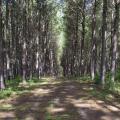Carbon Credits
Carbon dioxide, or CO2, (often called simply carbon), is one of several chemical compounds known today as greenhouse gases, or GHG. These gases occur both naturally and as byproducts of fossil fuel use in various transportation and industrial processes. CO2 comes from many different sources. It can be natural, as when it comes from a volcano, but it can also come from fossil fuels being used to create energy for our cars or to power our electricity-generating plants.
International efforts have been under way for many years to reduce or offset the amount of carbon that is emitted into the atmosphere. Industries are retooling operations to release less carbon dioxide, and some are purchasing carbon credits to offset some of the carbon dioxide production that they have not been able to effectively and economically eliminate. Trees take in carbon dioxide from the atmosphere and store it. Most carbon is stored, or sequestered, in the wood and accounts for one-half of the dry weight. Carbon remains in the wood throughout the life of the forest product.
Voluntary carbon markets provide a means where companies or individuals can purchase carbon credits merely for the sake of offsetting GHG emissions. An Involuntary, or Compliance, carbon market is a mandated or regulated market where companies must purchase carbon credits to offset their emissions beyond some specified GHG emission – a “cap.” Sometimes involuntary carbon markets are referred to as “cap-and-trade” markets.
Newly planted trees and some existing stands have qualified under the Voluntary Carbon Market as sequestered carbon. This allows forest landowners to sell these carbon credits to others who need to offset some of the carbon they are producing through industrial processes. A new type of carbon offset project is the deferment of a forest harvest, with the goal of increasing the amount of carbon stored and sequestered on the landscape at any point in time.
The amount of carbon you can claim compares to the amount of money you get for carbon offsets. Forestry offsets can be a very big contributor to reaching the cost of compliance with greenhouse gas reductions. For example, carbon sequestered in trees that are made into paper products does not have much permanence because paper’s lifespan is short. However, carbon sequestered into trees that are made into furniture has a much longer anticipated permanence. The value of carbon varies in these instances.
Within the United States there are currently several forestry-related Voluntary carbon markets. Currently, the most applicable for landowners within the Western Gulf region being the Natural Capital Exchange (NCX) program. This market is most applicable because of the short enrollment period (one-year), a relatively low acreage to enroll and subsequently participate, and no to little fees associated with enrolling in the market. NCX is a carbon market that is much more targeted at landowners with smaller acreages, landowners often referred to as Non-Industrial Private Forest (NIPF) landowners, or sometimes referred to as Family Forest landowners. There are also a few involuntary forestry-related carbon markets, the most notable in the United States being California’s Cap-and-Trade program which is overseen by the California Air Resources Board (CARB). There is also an opportunity for landowners to participate in these types of markets.
Contact Shaun Tanger at 228.546.1014, smt489@msstate.edu or Curtis VanderSchaaf at 601.857.2284, clv127@msstate.edu
News
Some Mississippi landowners selling carbon offsets through a company geared to smaller tracts of land have lost that source of income this year.
Curtis VanderSchaaf, a forester with the Mississippi State University Extension Service, said the one-year harvest deferral program previously offered by the Natural Capital Exchange, or NCX, has ended.



